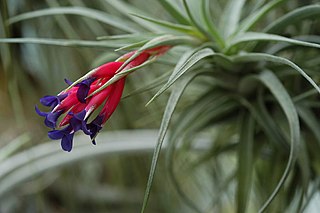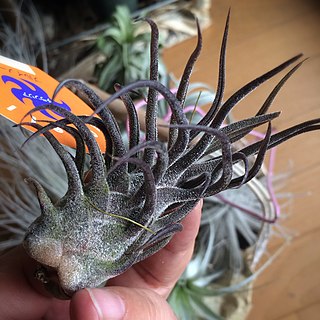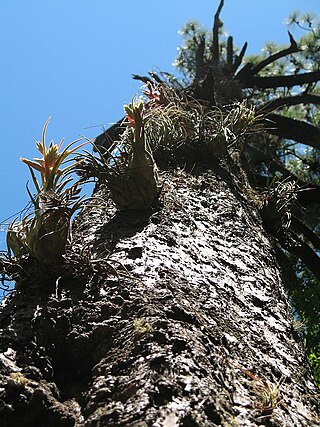
Spanish moss is an epiphytic flowering plant that often grows upon large trees in tropical and subtropical climates. It is native to much of Mexico, Bermuda, the Bahamas, Central America, South America, the Southern United States, and West Indies. It has been naturalized in Queensland (Australia). It is known as "grandpa's beard" in French Polynesia.

Tillandsia is a genus of around 650 species of evergreen, perennial flowering plants in the family Bromeliaceae, native to the forests, mountains and deserts of the Neotropics, from northern Mexico and the southeastern United States to Mesoamerica and the Caribbean to central Argentina. Their leaves, more or less silvery in color, are covered with specialized cells (trichomes) capable of rapidly absorbing water that gathers on them.

Tillandsia aeranthos is a species of plant in the genus Tillandsia. This species is native to southern Brazil, Paraguay, Uruguay, and Argentina.

Diaphoranthema is a subgenus of the genus Tillandsia.
Tillandsia subg. Phytarrhiza is a subgenus of the genus Tillandsia.

Tillandsia subg. Anoplophytum is a subgenus of the genus Tillandsia.

Tillandsia crocata is a species in the genus Tillandsia. This species is native to Brazil, Bolivia, Argentina, Paraguay and Uruguay.

Tillandsia geminiflora is a species in the genus Tillandsia. This species is native to Brazil, Suriname, Paraguay, Uruguay, and the Misiones Province of Argentina.

Tillandsia pruinosa, is a species of flowering plant in the family Bromeliaceae. It is commonly known as the fuzzywuzzy airplant. This species is native to northern South America, Central America, southern Mexico, the West Indies and Florida.

Tillandsia recurvifolia is a species in the genus Tillandsia. This species is native to Bolivia, Paraguay, Uruguay, Argentina, and Brazil.

Tillandsia stricta is a species in the genus Tillandsia. This species is native to South America and Trinidad.

Tillandsia tenuifolia, the narrowleaf airplant, is a species in the genus Tillandsia. This species is widespread across much of South America and the Caribbean islands.

Tillandsia xiphioides is a species in the genus Tillandsia. This species is native to Bolivia, Brazil, Paraguay, Uruguay, and Argentina.

Tillandsia fasciculata, commonly known as the giant airplant, giant wild pine, or cardinal airplant, is a species of bromeliad that is native to Central America, Mexico, the West Indies, northern South America, and the southeastern United States. Within the United States, this airplant is at risk of extirpation from the Mexican bromeliad weevil, Metamasius callizona. A related plant, Tillandsia utriculata, sometimes called the "Wild Pine" is endemic to the same areas.

Tillandsia ionantha, the air plant, is a species of plant in the genus Tillandsia. This species is native to Central America and Mexico. It is also reportedly naturalized in Broward County, Florida.

Tillandsia seleriana is a species of flowering plant in the genus Tillandsia. This species is native to southern Mexico and Central America.

Tillandsia streptophylla is a species of flowering plant in the genus Tillandsia. This species is native to Central America, Mexico, and the West Indies.

Tillandsia latifolia is a species of flowering plant in the genus Tillandsia. This species is native to Ecuador and Peru. Four varieties are recognized:
- Tillandsia latifolia var. divaricata(Benth.) Mez - Peru, Ecuador
- Tillandsia latifolia var. latifolia - Peru, Ecuador
- Tillandsia latifolia var. leucophyllaRauh - Peru
- Tillandsia latifolia var. majorMez - Peru

Tillandsia subg. Tillandsia is a subgenus of the genus Tillandsia.

Tillandsia subg. Aerobia is a subgenus of the genus Tillandsia.
















